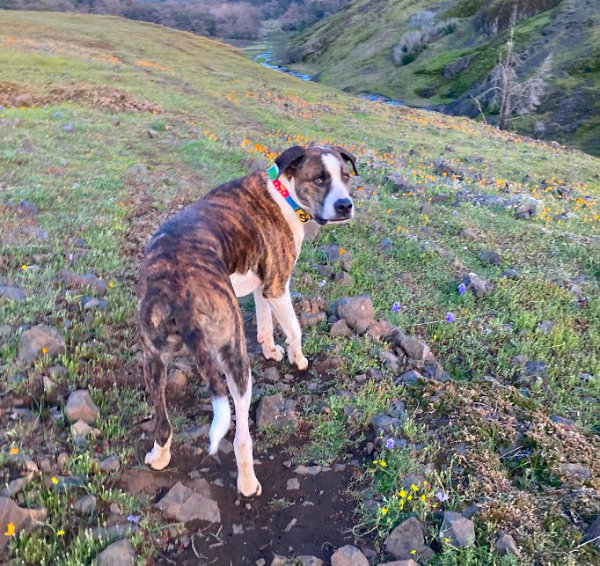I have relatives visiting from out of state, and after a two-day drive to get here, they want to stretch their legs on a hike. Since I am not sure how long they will be game to walk, I leave elderly Otto at home, and bring only 5-year-old Woody along with us.
We were maybe 100 yards up the trail, with Woody off-leash ahead of us by about 20 feet, when he stopped, looked at something on the ground in front of him, and looked back at me. I glanced down at whatever he was looking at and – “Woody! Off! Here!” He calmly and immediately stepped back away from the snake and trotted back to me for a jackpot of treats. “YES! What a good boy!”
We were close enough to see three or four “buttons” on the snake’s tail, but the snake never rattled them in alarm. Woody’s calm behavior didn’t upset the snake, and she did what rattlesnakes prefer to do when faced with humans or dogs: She slithered quietly off the trail and into the tall grass, out of sight.
We practice the “Off!” (a.k.a. “Leave it!”) behavior on every walk, and that event was exactly why. I want my dogs’ response to “Off!” to be instantaneous and calm. I want them to have every expectation that when they immediately turn away from whatever they were looking at or smelling when I gave the cue, and return promptly to me, that they will for sure get a treat – and just might get a jackpot. (That’s when they get a handful of treats, delivered one after another. A dog can eat a handful of small treats in about two seconds, but by delivering them one after another after another after another, it drags out the handful into a good 15 or 20 seconds of sustained nomming. It’s way more special than a handful given at once. It takes advantage of the same principle behind the programming of slot machines to let coin jackpots trickle out a bit at a time, instead of dumping all the coins into the tray at once: It seems like more!)
I think this training is essential for every dog who is walked off leash. But I know that I’m lucky; neither of my dogs is particularly predatory. If they were, I couldn’t ever let them walk off-leash in our neck of the woods from May through October, because instead of looking back at me with that, “Hey Mom? What’s this?” expression, I know that some dogs would just dive in and try to grab it, with potentially disastrous results. There are too many snakes around here to walk with a predatory dog off-leash. But even with my non-predatory dogs, the snake on the trail is exactly why we practice and practice some more.
For lots of information about rattlesnakes, their bites, preventing and treating snake bites, and training your dog to leave snakes (and other things) alone, please see all the following:
https://qa.whole-dog-journal.com/care/how-to-prevent-or-treat-bites-from-poisonous-snakes/
https://qa.whole-dog-journal.com/care/snake-avoidance-training-for-dogs/
https://qa.whole-dog-journal.com/care/are-you-sure-it-was-a-rattlesnake/
https://qa.whole-dog-journal.com/care/appreciating-rattlesnakes/
https://qa.whole-dog-journal.com/care/why-are-the-effects-of-snake-venom-so-varied/
https://qa.whole-dog-journal.com/care/a-snake-bite-survival-story/







Excellent and timely article!
Thank you!
Yes, excellent article and fantastic reminder of this type of training that is so easy to practice.
But a question, and forgive our naivete; but how do you know if a dog is predatory or not, as you put it?
We thought all dogs had predatory instincts. At least that is what we have observed.
And, at what point did you feel your dog reached the level the dog displayed in this scenario?
Hi there,
I’m going to answer your excellent question in this week’s blog post (which will appear on Thursday).
What a well-trained dog! Here in Western Australia we encounter, like you, many snakes – mostly lethal – and my dog just backs off and runs back to me to protect her – no training involved – more instinct and a good dose of cowardice. She is a Bull Arab – looks similar to Woody.